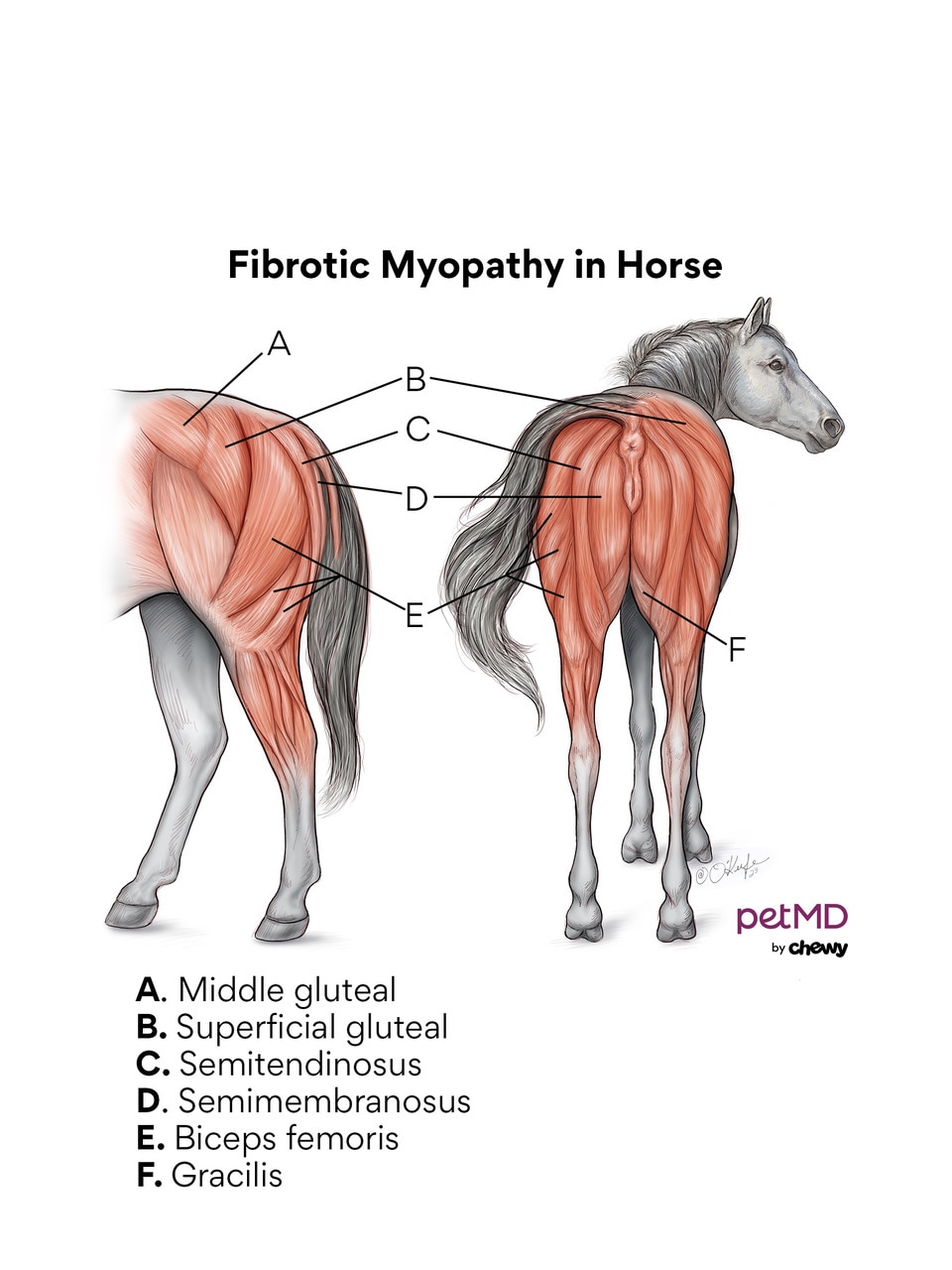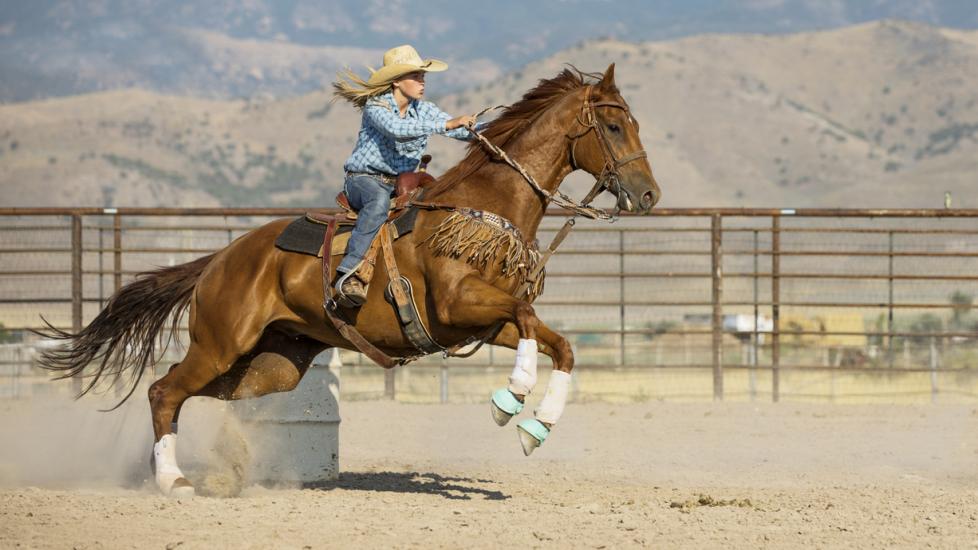Fibrotic Myopathy in Horses
What is Fibrotic Myopathy in Horses?
Fibrotic myopathy (sometimes called ossifying myopathy) occurs after a horse tears the semimembranosus and/or semitendinosus muscles in the hamstring, usually due to trauma. The torn muscle eventually transitions into contracted scar or fibrotic tissue, causing further dysfunction of the limb. This disorder is overrepresented in Quarter horses, primarily due to their athletic maneuvers used in competitions.

Symptoms of Fibrotic Myopathy in Horses
After an acute injury, the involved muscles may feel slightly warm to the touch, have swelling, or be indented if there is a significant tear. Your horse will be lame in one leg and reluctant to move.
Over a few months, the affected muscle fibers will harden to become fibrotic scar tissue. This further limits movement by preventing full extension of the limb. Horses will develop a characteristic slapping or “goose-stepping” gait in the affected leg—the cranial (forward) phase of the stride stops suddenly when the muscle is extended to its new limit, and the foot is jerked down abruptly rather than continuing forward motion. This gait is called a mechanical lameness that is due to inappropriate or decreased function, rather than pain.
Causes of Fibrotic Myopathy in Horses
Common causes of fibrotic myopathy include:
-
Trauma
-
Multiple episodes of overextension or strain, particularly seen in Western performance horses
-
Abrupt turns
-
Slides
-
Pulling/straining if leg gets stuck
-
Intramuscular injection
-
Congenital condition
How Veterinarians Diagnose Fibrotic Myopathy in Horses
While the semitendinosus and semimembranosus are the most common muscles causing fibrotic myopathy, other muscles in the upper hind limb can also be involved. Diagnosis can be made in chronic cases by examining the band of scar tissue in the muscles along with the characteristic slapping gait.
Along with a physical examination, ultrasound can be a very useful tool in diagnosis, allowing visualization of the extent of torn muscles and presence of scar tissue. Nuclear scintigraphy, a more intensive and expensive form of imaging, may be recommended in some cases if surgery is going to be pursued. Biopsy can also be useful to determine the amount of fibrous tissue present; this may look normal shortly after injury but will change over time.
Treatment of Fibrotic Myopathy in Horses
After an acute injury, therapy should begin as soon as the horse is no longer in pain to prevent ossification (hardening) of the muscle. If your horse has local heat and inflammation, your veterinarian may prescribe an anti-inflammatory such as Phenylbutazone or Banamine (flunixin meglumine) during the early stages.
Treatment plans may include hydrotherapy (cold hosing the area), stretching, alternative therapies including deep ultrasound, and heat or electric stimulation. Underwater treadmill exercises can also be beneficial once the muscle has started to heal. The aim of post-tear therapy is to regain as much normal elasticity and strength of muscle as possible, and prevent the development of excess scar tissue or fibrosis.
If a fibrotic band does occur in the muscle, surgery may be required to correct that tissue. Prognosis for full return to normal mobility is poor in chronic cases. There are two surgical options typically discussed for fibrotic myopathy, including a tenotomy, which cuts the semimembranosus tendon at its insertion point on the tibia, or a myotomy which cuts the band of scar tissue present. Myotomies are typically performed in the standing horse with minimal sedation using local anesthetics. The horse may be moved a few steps forward out of the stocks to determine if the band has been completely cut to visualize normal motion.
Recovery and Management of Fibrotic Myopathy in Horses
Rehabilitation and therapeutic plans recommended by your veterinarian should be followed closely. If your horse undergoes surgery, it is critical that post-surgical therapy plans are followed strictly, which will involve light, controlled exercise with gradually increasing length and difficulty over a few months' time. This ensures that the muscles are allowed to strengthen and prevent further fibrosis and decreased elasticity.
Some horses are able to return to full work with a normal gait if treatment is instituted early. Horses with severe fibrosis of the muscles are often retired to pasture. They will continue to have the goose-stepping gait for the rest of their lives.
Horses with chronic ossification of the muscle strands that have an abnormal gait for life may be more predisposed to developing arthritis in the involved limb.
Prevention of Fibrotic Myopathy in Horses
While accidents are not always preventable, some causes of fibrotic myopathy can be prevented with appropriate management practices such as:
-
Avoid giving intramuscular injections in the semitendinosus/semimembranosus muscles, and never inject potentially caustic medications intramuscularly such as Banamine.
-
Provide a thorough warm-up and cool-down period for your equine athlete; cold or tense muscles have a higher likelihood of tearing with abrupt movements such as slides and sharp turns.
-
Have your horse’s hooves trimmed or shod regularly to maintain proper balance. Many issues higher up in the leg can be traced down to instability or imbalance of the hoof. Hoof health is vital in keeping your horse agile and lengthening the life of their mobility. There are many hoof, muscle, and joint supplements available; discussing these with your veterinarian may also be beneficial.
Featured Image: iStock.com/diane39
